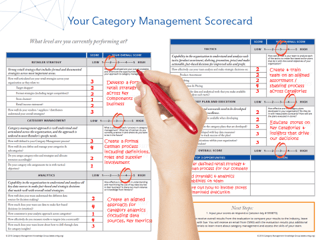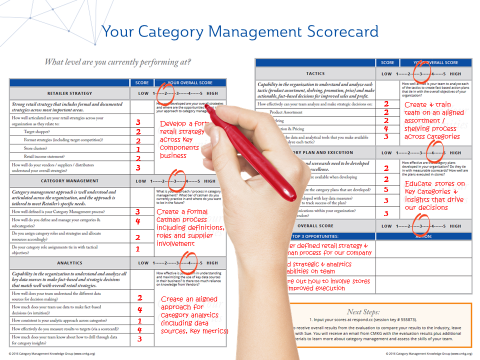The retail industry is changing.
- Retailers are vying for market share in an increasingly competitive environment.
- Shoppers are becoming more complex and demanding.
- Data and technology options are increasing in complexity with more and more big data.
- Channels are blurring.
Retailers have a big opportunity to create well defined strategies and processes that will help align and guide their organizations so that they can achieve their goals and objectives. But where should you begin for category management in retail environments?
A Well Defined Retailer Strategy + Category Management Process = Strong Foundations for Retail Success
I recently facilitated a category management training session on “Assessing Your Category Management Approach” at a retail educational conference in Dallas. The objective of the session was to help Retail Executives identify the areas of their overall strategies and category management processes that are well defined and those that require their attention.
Attendees evaluated their organization on our Category Management Scorecard (below), including these key components:
- Retailer Strategy
- Category Management
- Analytics
- Tactics
- Category Plan and Execution

CATEGORY MANAGEMENT REPORT CARD EXAMPLE
What were their results?
Feedback from the session was very positive (it was a fun session to facilitate too!). At the end of the session, participants anonymously shared their overall scores via their mobile devices and the results were astounding.
Overall, the average score of how Retailers rated their organizations strategic category management approach "Low-Medium". The top 3 opportunities for improvement they cited were:
- OPPORTUNITY #1: Develop better-defined Retailer strategies
- OPPORTUNITY #2: Develop consistent category management processes across the organization
- OPPORTUNITY #3: Develop aligned category plans in key categories and execute effectively in-store
What would YOUR results be? Find out.
I invite you to join me for the next 5 weeks while I walk through the 5 key components that create a solid foundation for success.
Each week, there will be:
- Short online questionnaire that will provide the opportunity to evaluate your strategic approach
- Topline results from the previous week’s evaluation
- Introduction to the next key component.
PART 1: YOUR RETAILER STRATEGY
Retail strategy creates the foundations for the rest of your Category Management process. It needs to be well documented and well understood by your organization.
Senior management in the retail organization defines the overall strategies, and ultimately, all category and business plans align to the overall Retailer strategies.
Specifically, these strategies create the rules, guidelines and processes that help the organization make the most strategic decisions. They ensure that there is a consistent approach from headquarters all the way down to shelf execution. A solid strategy should include:
- The services offered (e.g. hours / locations / customer service / additional services / return policies)
- The target Shopper (e.g. most loyal Shopper groups / demographics by retail store cluster / overall target Shopper demographic groups by banner or cluster)
- Targeted competition (e.g. key competition by banner and/or region based on similar target Shoppers)
- Overall product assortment strategies (e.g. what categories are carried by the Retailer / different store clusters AND what is the range of items that they will offer (example strategies: large size focus, premium segment strategy, private label / store brand strategy)
- Shelving strategies (e.g. store layout / category adjacencies / category layouts) (example strategies: vertical / horizontal blocking; private label placement strategies; consumer-focused strategies using decision trees)
- Pricing strategies (e.g. #1 competition / guardrails / regional considerations / price tracking) (e.g. #2 cheapest price / premium price / hot priced features (high-low) / everyday low price (EDLP) / price matching / private label pricing thresholds vs national brands)
- Promotion strategies (e.g. #1 Marketing strategies — brand, retail, flyer programs, event marketing); (e.g. #2 Promotion or Flyer Program strategies — flyers, in-store specials such as: number of flyers, frequency, ad scheduling processes, ad allocation, private label promotion strategies)
- Private label / store brand strategies (e.g. things to include: overall strategies for each different brand / target consumers by brand / price tier & quality for each brand)
Now that we’ve got the basics, it’s time for you to evaluate how well your organization is doing. Head over to Part 1 of our Category Management Scorecard now and check back next week for the results.



